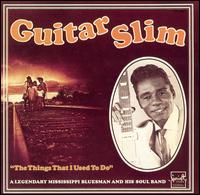The Things That I Used to Do
| "The Things That I Used to Do" | ||||||||
|---|---|---|---|---|---|---|---|---|
 |
||||||||
| Single by Guitar Slim | ||||||||
| B-side | "Well, I Done Got Over It" | |||||||
| Released | 1953 | |||||||
| Format | 7-inch single | |||||||
| Recorded | October 16, 1953 | |||||||
| Studio | Matassa's J&M Studio, New Orleans | |||||||
| Genre | Blues, electric blues, New Orleans blues | |||||||
| Length | 3:38 | |||||||
| Label | Specialty | |||||||
| Writer(s) | Eddie Jones a.k.a. Guitar Slim | |||||||
| Producer(s) | Ray Charles | |||||||
| Guitar Slim singles chronology | ||||||||
|
||||||||
|
||||||||
| "The Things That I Used to Do" | ||||
|---|---|---|---|---|
| Single by James Brown | ||||
| from the album Showtime | ||||
| B-side | "Out of the Blue" | |||
| Released | 1964 | |||
| Format | 7-inch single | |||
| Genre | Rhythm and blues | |||
| Length | 2:55 | |||
| Label | Smash (1908) | |||
| Writer(s) | Eddie (Guitar Slim) Jones | |||
| Producer(s) | Fair Deal | |||
| James Brown charting singles chronology | ||||
|
||||
"The Things That I Used to Do" is a 12-bar blues song written by Guitar Slim. His recording of it, made in New Orleans, was arranged and produced by the young Ray Charles. It was released by Specialty Records in 1953 and became a bestseller the following year. It was one of the biggest hits in the label's history and stayed on the rhythm and blues charts for 42 weeks. The song was at number one for six weeks and was the best-selling R&B record of the year, selling more than a million copies.
Since Guitar Slim was a blues artist, Art Rupe, of Specialty Records, figured that his appeal would be limited to the Southern rural audience. However, urban R&B stations in the North picked up the song, building it into a national hit. As a result, Guitar Slim became in great demand as a performer and played at the Apollo Theater.
Charles's arrangement and piano accompaniment emphasize the religious tone of intense but philosophical regret in the singer's voice, giving the song a gospel-influenced feel. Like Fats Domino, Guitar Slim had a voice with a less adult sound than that of the typical blues shouters of the time, and his lyrics are less explicitly sexual.
The song required numerous takes to record. Jones often stopped playing in the middle of the song for some reason, and they had to start from the beginning again. (Even in the take which was issued, Jones resumed the vocal after the instrumental chorus half a bar early, singing and playing two beats ahead of the band for the first eight bars of the final chorus.) During the song's fadeout Charles shouted "yeah!" as he realized that they had finally managed to make it to the end.
The song was a huge success, greatly influencing rock and roll by demonstrating the commercial success of using content that appeals to white listeners and by the effectiveness of its gospel feel. It has become a standard as a result of Guitar Slim's distinctive guitar figuring and the rising and falling melody. It had a major impact on the "electric sound" of rock music and featured distorted overtones on the electric guitar a full decade before Jimi Hendrix. It has been listed by the Rock and Roll Hall of Fame as one of the 500 songs that shaped rock and roll. It also contributed to the development of soul music.
...
Wikipedia
